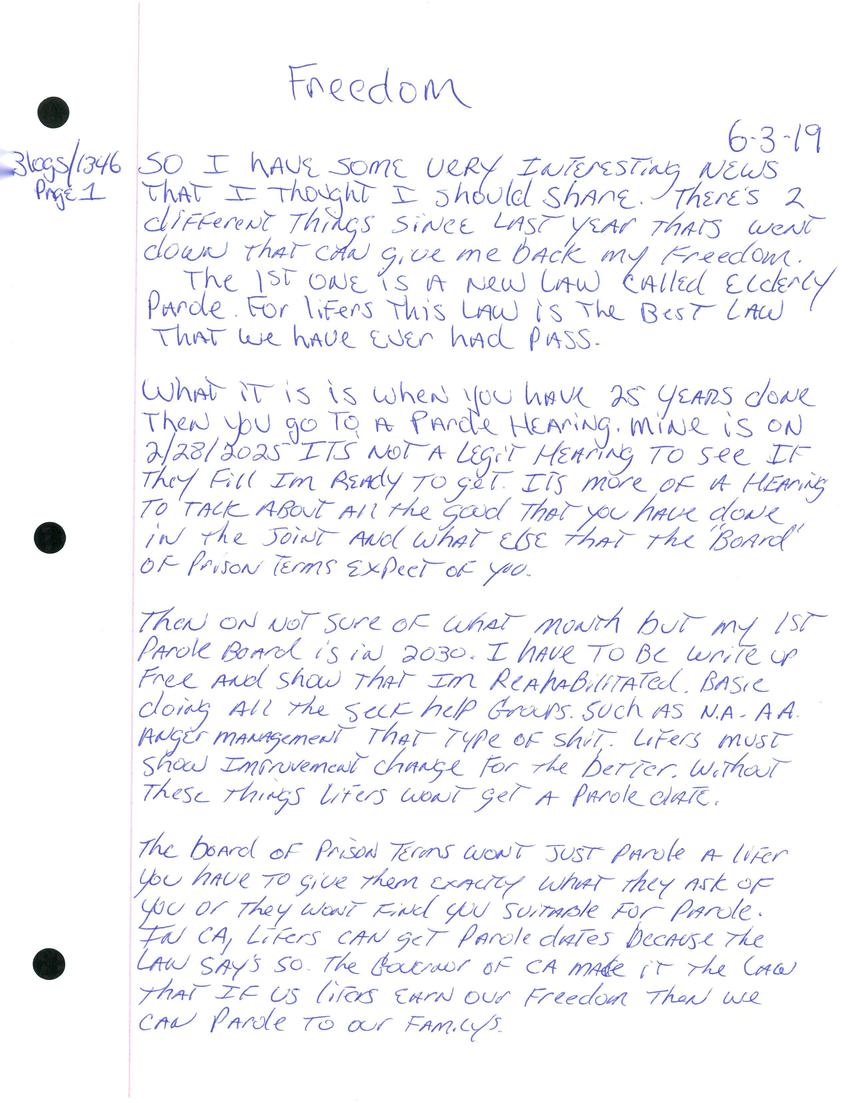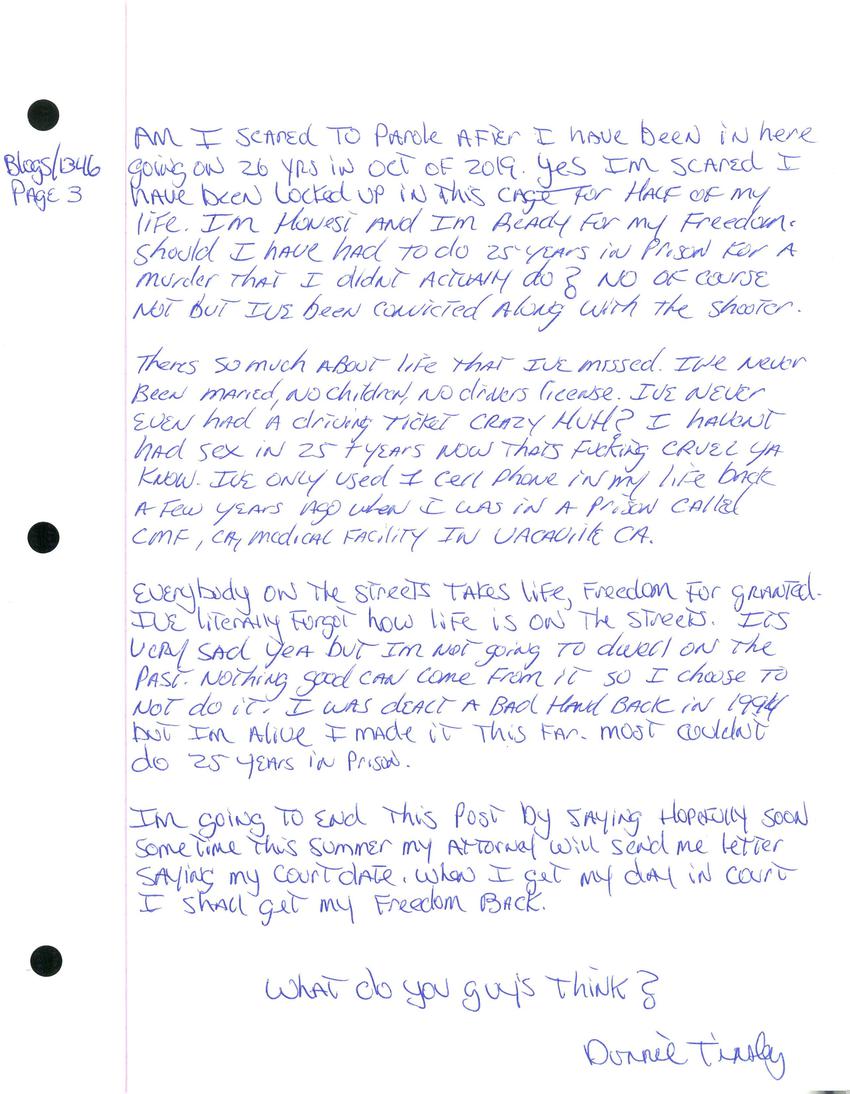
Transcription
6-3-19
Freedom
So, I have some very interesting news that I thought I should share. There's two different things since last year that's went down that can give me back my freedom.
The first one is a new law called Elderly Parole. For lifers, this law is the best law that we have ever had passed.
What it is, is when you have 25 years done, then you go to a parole hearing. Mine is on 2/28/2025. It's not a legit hearing to see if they feel I'm ready to get out. It's more of a hearing to talk about all the good that you have done in the joint and what else that the Board of Prison Terms expect of you.
Then on, I'm not sure what month, but my first parole board is in 2030. I have to be write up free and show that I'm rehabilitated. Basically, doing all the self-help groups such as N.A., A.A., anger management—that type of shit. Lifers must show improvement and changes for the better. Without these things, lifers won't get a chance at a parole date.
The Board of Prison Terms won't just parole a lifer. You have to give them exactly what they ask of you or they won't find you suitable for parole. In CA< lifers can get parole dates because the law says so. The governor of CA made it the law that if us lifers earn our freedom, then we can parole to our families.
On January 1, 2019, the Homicide Law was changed but only certain people will get action. For instance, say you and your friend decide to go rob the weed connection for his pot plants. When you two get to his pad, your friend shoots or kills him while taking his weed. In CA, when they catch you and your friend, you both will be charged for the murder and convicted in trial—for sure.
The new Homicide Law states you have to first, be the actual killer and not aid in the killing. Your intent was a robbery not a murder. Basically, if you're the driver at the bank robbery and not the dumbass who shot and killed someone during the robbery, then you won't be convicted of the murder.
Check it out.
I wasn't the trigger man in my case, but I was convicted along with the killer. I've done 25 years already for a murder that I didn't do.
Here's the good news. I filed under the new Homicide Law. It's called SB 1437. I just found out that the courts have given me a public defender to fight for me. He will represent me in the court, answering my petition that states that I'm not the trigger man. Therefore I'm asking that I be resentenced under SB 1437. That my murder conviction be vacated and I be resentenced to serve time.
Am I scared to parole after I have been in here going on 26 years (come October 2019)? Yes, I'm scared. I have been locked up in this cage for half of my life. I'm honest and I'm ready for my freedom.
Should I have had to do 25 years in prison for a murder that I didn't actually do? No, of course not. But I've been convicted along with the shooter.
There's so much about life that I've missed. I've never been married, no children, no driver's license. I've never even had a driving ticket. Crazy, huh? I haven't had sex in 25 years now. That's fucking cruel, ya know. I've only used one cellphone in my life, back a few years ago when I was in a prison called CMF (California Medical Facility) in Vacaville, CA.
Everybody on the streets takes life and freedom for granted. I've literally forgot how life is on the streets. It's very sad, yeah, but I'm not going to dwell on the past. Nothing good can come from it. So, I choose not to do it.
I was deact a bad haul back in 1994, but I'm alive. I made it this far. Most couldn't do 25 years in prison.
I'm going to end this post by saying hopefully soon, sometime this summer, my attorney will send me a letter saying my court date. When I get my day in court, I shall get my freedom back.
What do you guys think?
[signature]
Other posts by this author
|
2020 nov 9

|
2020 may 6

|
2020 may 4

|
2020 mar 31

|
2020 feb 19

|
2019 sep 3

|
More... |




Replies (18)
I remember having read an article on this new law, I will drop this article hear (copy paste, not typing over) maybe sth in it is interesting to you...
LANDMARK CALIFORNIA LAW BARS PROSECUTORS FROM PURSUING MURDER CHARGES AGAINST PEOPLE WHO DIDN’T COMMIT MURDER
November 23 2018 The intercept
JACQUE WILSON WAS in his car heading home from a softball game on a late August evening when his phone rang. It was his friend Kate Chatfield: She told him California Senate Bill 1437 had finally passed and was headed to Gov. Jerry Brown’s desk. “And I’m driving, and I just break down crying,” Wilson told The Intercept.
The new law would dramatically redefine use of the state’s archaic felony murder rule in criminal prosecutions. It would also mean that Wilson’s younger brother Neko might finally be coming home after more than nine years behind bars awaiting trial for a grisly crime that he insists he played no part in.
Neko Wilson was one of six people charged with the robbery-murder of Gary and Sandra DeBartolo, who had an illicit marijuana grow operation inside their Fresno County home. The state alleged that Neko and the others planned to steal the dope and whatever cash was in the house. But that plot apparently went sideways. Minutes after two of the accused conspirators, Leroy Johnson and Jose Reyes, entered the DeBartolos’ home on the morning of July 22, 2009, the couple was killed, their throats slashed. After a high-speed chase, police caught up with the getaway car.
Neko was not at the DeBartolos’ house that day, and he wasn’t in the getaway car. Still, he was arrested and charged with the couple’s murder. Prosecutors announced that they would seek the death penalty for Neko under the felony murder rule.
A throwback to English common law, the felony murder rule works like this: Say two people decide to burgle a house, and in the process, one of them shoots and kills the homeowner; even if the shooting was completely spontaneous, and even if one of the burglars didn’t know the other had a gun, both could be held equally liable for the murder. Neko Wilson might not have been there when the DeBartolos died, but prosecutors alleged he was the one who hatched the plan for the robbery, which meant he was responsible for what happened even if he didn’t kill anyone.
Most states have some version of the felony murder rule on the books, and in a number of states, it can be used to seek the death penalty. In Texas, five men have been executed for murders that they did not commit (a sixth is slated for execution in December). Although a handful of states have curtailed or eliminated this brand of accomplice liability, California’s law had remained active — much to the chagrin of people like Jacque Wilson, who is also an attorney with the San Francisco Public Defender’s Office.
It wasn’t a particularly easy lift, but after a dramatic final vote in the state Assembly, the bill did pass, and in September, it was signed by Brown. It is now poised to serve as model legislation for reform-minded lawmakers across the country.
A Check on the Power of Prosecutors
STATE SEN. NANCY Skinner’s district is in Alameda County, just east of San Francisco. She said she had no idea that felony murder was something that existed until she started hearing about it from constituents and advocates.
She remembers meeting with the family of an incarcerated woman who was prosecuted under the rule. The woman had been on a third date with a guy “who, in hindsight, she never should’ve dated,” Skinner said. The guy was a gang member. The woman was in the car with him and several other members of the gang when there was a drive-by shooting. “She was not aware that would happen,” Skinner recalled, “and yet she was charged with felony murder.”
What Skinner learned convinced her to co-author SB 1437. Put simply, she said, felony murder is not fair because it divorces intent from action.
California’s new law bars prosecutors from using a person’s intent to commit one crime — for example, a robbery — as a way to hold them responsible for a murder committed during the course of that robbery, unless they can prove that the person played some direct role in the killing.
Also significant is that the law is retroactive, meaning it affects the cases of those already in prison, and applies equally to individuals who accepted plea deals — two provisions that are often a tough sell: The criminal justice system favors finality and relies on plea bargains to keep it humming along, and lawmakers are often loath to intervene.
Exactly how many people may be eligible for release under the new law isn’t entirely clear, in part because of the way records are kept. Nationally, it is estimated that a staggering 20 percent of individuals convicted of first-degree murder were sent to prison under felony murder provisions. Based on that, Re:store Justice estimates that there are roughly 800 people incarcerated in California for first-degree felony murder who may find relief under the new law. The number of individuals convicted of second-degree felony murder who would be eligible is currently unclear, as is the number of those who pleaded guilty (though it is possible that some are included in the 800-inmate estimate).
In 2016, another state lawmaker filed legislation that would have provided more clarity, by requiring district attorneys to collect data on individuals they charged with and convicted of felony murder. Despite broad support, the bill ultimately failed under pressure from the district attorneys’ lobby.
The sheriffs’ association also said the bill’s retroactivity was a problem. That was particularly true for cases that resulted in a plea deal, lobbyist Cory Salzillo told the senators, since it isn’t “always the case” that prosecutors have actually “proved up every fact” of a crime or a defendant’s alleged involvement before entering into a plea deal.
But when questioned by a member of the committee about why the felony murder rule was needed, Hoffman seemed to have a difficult time. After all, state Sen. Steven Bradford noted, a person who committed a robbery in which someone was killed could be charged with manslaughter if the facts warranted. And there was nothing in the law that would bar a prosecutor from charging a non-killer participant in connection with their role in the underlying felony. So, Bradford asked, why would a prosecutor use the rule? It would be case-specific, Hoffman responded.
“Your questioning is precisely why I am carrying this bill and trying to narrow the application” of the rule, Skinner told Bradford. “Because there is — depending on your perspective — one could say that this has evolved into a far greater amount of prosecutorial discretion than we may have intended.”
Chatfield thinks that prosecutors opposed the bill precisely because it is a direct check on their discretion. “This makes them have to prove these elements beyond a reasonable doubt, which is what they should be doing anyway,” she said — as opposed to overcharging defendants in order to force a plea deal. “You can’t just round up five people when you know four people didn’t do the killing; you know they’re not culpable. But you get to go right at them and use your discretion in that way. And we’re saying no.”
She points to several stories from across the state that Re:store Justice put together in a publication for state lawmakers. They reflect the wide breadth that prosecutors are given in deciding who to charge with murder — including in the case of a woman who was passed out in a car blocks away when a murder happened. “That’s how that prosecutor used his discretion,” she said.
FOR ALL THE hand-wringing about how curtailing the use of felony murder would tie prosecutors’ hands, force them to revisit old cases, and allow some defendants to go free, there is still a large group of people incarcerated in California under the rule who the new law will not immediately effect: Those serving death sentences or life without parole, even when their connection to the crime might have been tangential or tenuous.
In California, the imposition of a sentence of death or life without parole requires a “special circumstance” finding — that the defendant was a “major participant” in the crime or acted with “reckless indifference” to human life. These add-ons were created by ballot initiative back in 1978 and can only be changed by another initiative or a supermajority vote in the Legislature.
But even a jury’s finding that one or both of these special circumstances applied to a particular case doesn’t necessarily tell the whole story, says Joanne Scheer, founder of the Felony Murder Elimination Project and a co-sponsor of SB 1437. Her son Tony Vigeant is serving life without parole after a jury concluded both special circumstances applied to his role in the murder of a man named David Pettigrew in 2007.
According to the state, Vigeant and his cousin, both Marines who were stationed at Camp Pendleton, enticed a third service member, Ramon Hernandez, who had sustained a major brain injury during a tour of duty in Iraq, to shoot Pettigrew in a dispute over an alleged drug debt. Scheer disputes that narrative and says that what actually happened was a tragedy rooted in a string of poor, but pedestrian, decisions. After a day of watching football and drinking beer, Scheer says, the three Marines decided to go to Pettigrew’s to collect a laptop that Vigeant had sold him, but that Pettigrew had not yet paid for. Vigeant knew Hernandez had a gun, says Scheer, but it never occurred to him that anything would happen at the apartment, let alone a murder.
Scheer has been working with California’s corrections department to try to figure out how many inmates may be serving a life-without-parole or death sentence based on a theory of felony murder. As of the end of July, there were 5,206 people serving life without parole in the state; of those, more than 3,700 were first-time offenders and more than 3,200 were under the age of 25 at the time of the crime. Because it appears that so many individuals convicted under accomplice liability are young, first-time offenders, Scheer suggests that a large number of inmates serving life without parole might have been swept into prison under the rule.
Although SB 1437 doesn’t provide direct relief to people like Vigeant, the California Supreme Court has created an avenue for potential review. The court opined back in 1983 that the felony murder rule could be “barbaric” in application, and in more recent years, it has issued a string of decisions that would rein in indiscriminate use of the “major participant” and “reckless indifference” special circumstances that can so dramatically increase punishments. The court’s decisions have provided a framework for a defendant to have the imposition of special circumstances reviewed; if the courts agree they were improperly applied, they can be tossed out. If that happens, the case could be eligible for review under the provisions of SB 1437.
If Neko Wilson had gone to trial soon after he was arrested in 2009, he might be in the same boat as Vigeant — after all, the state signaled early on its intention to seek the death penalty. But there were flaws with the case from the get-go, says his brother and defense lawyer Jacque Wilson, including repeated failures by the state to turn over key exculpating evidence. The years that Jacque spent fighting the state meant that Neko was still in jail awaiting trial when SB 1437 finally passed out of the Assembly on August 29.
Jacque had been sweating it out, waiting to see if the bill would pass — and for a while, things in the Assembly looked dicey. Lawmakers on each side of the debate made impassioned speeches on the floor, urging colleagues to follow their lead. When the voting started, it didn’t look like the bill would get the 41 votes necessary. Chatfield was there, pacing the hallways, sending texts, and making calls in an effort to gin up final support. As it turned out, Brown, a supporter of the legislation, was making calls of his own. The vote was held open, and finally, with 42 votes, the measure passed. That’s when Chatfield called Jacque. Both of them broke down in tears.
Fresno prosecutors dropped the charges against Neko, and on October 18, he was the first person freed by the new law. Relief flooded Jacque. After Neko was arrested, their father, Mack, told Jacque that all he wanted was to be able to touch his son again. Now 83, he’s been able to do that. “From my family’s perspective,” says Jacque, “this is a miracle.”
Violent Crime as Part of the Equation
ALEXANDRA MALLICK, EXECUTIVE director of Re:store Justice, hopes the new law will provide the same relief for other families in California — and potentially elsewhere.
The U.S. is an outlier when it comes to felony murder, says Lara Bazelon, director of the Criminal Juvenile Justice and Racial Justice clinics at the University of San Francisco law school. “It’s hundreds of years old, and the rest of the Western world has turned its face against it and has abolished it,” she said. “The U.S. stands alone.”
Although there are roughly 40 states that have some version of the felony murder rule, there are some that have curtailed or abolished it altogether, including Arkansas, Hawaii, Kentucky, Massachusetts, Michigan, and Ohio. Since passage of SB 1437, Mallick and Chatfield say they’ve been fielding inquiries from across the country from individuals and groups interested in passing similar legislation in their states. Chatfield has heard from lawyers in New York and Pennsylvania. Attorneys from Massachusetts have called, too; they’d like to see their provisions made retroactive. Mallick says she’s been in touch with a group in Texas interested in pushing for reform during the state’s 2021 legislative session.
Mallick says that part of what’s so meaningful about California’s reform of the felony murder rule is that it has addressed the issues of system reform and violent crime head on. “Doing stuff that deals with violence or issues around violence is not incredibly popular,” she said. “But my belief is that you can’t really move the needle with mass incarceration unless you talk about issues around violence.”
Chatfield agrees and hopes that California’s success will lead to more discussion and action. “I think it starts a conversation about what we talk about when we talk about ‘violence.’ What does it mean when we talk about murder? If somebody doesn’t do anything to facilitate that murder and doesn’t have that intent, what does it mean to call that person a murderer?” she asks. “I think it’s a very important conversation about how we’ve labeled a lot of our crimes. And if we can address something called ‘felony murder’ and educate people, we can educate people about a lot of things.”
I think Senate Bill 1437 is a good thing, and I can imagine it being also scary to have to adapt to the outside world after 25 years.
You wrote "Everybody on the streets takes life and freedom for granted.", but you will not be the first released lifer, so you also will not be the only one taking life and freedom not for granted. That was my thought when I read that sentence.
All the best with getting used to the thought of getting released soon,
Julia
This pink haired chic needs you to send me your address.
I told ya what was supposed to get for that B.S. It is kinda sorta a better deal than I thought. I kept all your letters I just need to find them. I will explain more via snail mail.
Have it good
~Pinky
thank you for your letter of 22 july. I am aware that it takes a long time to respond even if you write the same day, as you did apparently. Nice thing is that meanwhile I totally forget about it and then it is a nice surprise to find my name at the head of an entry :)
Sorry to hear that it does not go without a fight, this Senate Bill 1437. Just looked it up and found some stuff again:
PUBLISHED: JULY 1, 2019
https://calmatters.org/commentary/felony-murder-reform/
Prosecutors should stop the scare tactics. Reforming felony murder rule improves our justice system
by Nancy Skinner and Joel Anderson
In January, California ended a decades-old legal doctrine that put numerous people behind bars for murders they did not commit.
Yet six months after the new state law—Senate Bill 1437—took effect, some prosecutors are trying to overturn it, resorting to scare tactics and false distortions.
We are the legislators who wrote and supported this critical reform, and we need to set the record straight about it.
SB 1437 passed the Legislature last year with bipartisan support and was signed into law by then-Gov. Jerry Brown. It reformed California’s outdated and unfair felony murder rule, which had allowed people who did not kill to nonetheless be charged, convicted, and sentenced as murderers.
The old felony murder doctrine allowed prosecutors to charge all accomplices to a crime with first degree murder. It did not matter if there was no intention to kill, if the death was accidental, or if the accomplice had no knowledge that someone else would kill. Everyone was just as responsible, as if they had planned and committed the murder themselves.
The California Supreme Court, in a 1983 ruling, termed the state’s felony murder rule “barbaric.” And yet it remained on the books, and people were unfairly sentenced to long prison terms under this law.
We studied this issue for over a year before passing Senate Concurrent Resolution 48 in 2017. That measure recognized “the need for statutory changes to more equitably sentence offenders in accordance with their involvement in a crime.”
Then in the following legislative session we introduced SB 1437 to correct what we concluded was a grave and needless injustice.
As SB 1437 moved through the legislative process, we made significant improvements to ensure it was fair and that our reform did not let people who are responsible for a murder off the hook.
Based on input from district attorneys and other public safety advocates, we amended SB 1437 to ensure that a criminal was held accountable for murder if they:
Aided, abetted, counseled, commanded, induced, solicited, requested, or assisted the actual killer with the intent to kill.
Were a major participant in the underlying crime and acted with reckless indifference to life.
And so it’s been disappointing to see some of California’s district attorneys now working to block the law’s implementation. They remain intent on pursuing murder convictions for people not guilty of that crime, despite the fact that it’s not in the interest of public safety nor is it just.
Yet they have challenged SB 1437 in court arguing it’s unconstitutional on the grounds that it’s allegedly inconsistent with two ballot initiatives California voters passed decades ago.
Before introducing SB 1437, we spent over a year carefully reviewing past statutes, court decisions, and, yes, voter-approved ballot initiatives, to ensure that the provisions in SB 1437 did not overstep our role.
SB 1437 falls squarely within the Legislature’s broad authority to make policy.
Prosecutors have also challenged SB 1437 in the press with mischaracterizations. The president of the Association of Deputy District Attorneys for Los Angeles County, for example, recently told The New York Times that under SB 1437, “We’re literally talking about letting murderers go free.”
That’s a false claim designed to stoke fear.
Thankfully, many prosecutors have properly applied the law, and courts around the state have upheld the reform as constitutional. As a result, many deserving people have been able to go home—some after serving decades in prison for murders they did not commit.
It’s not just those newly freed and their families who have recognized the justice served in these cases. In San Luis Obispo County, after a judge found SB 1437 constitutional, a reporter went to the parents of the victim.
They said that while they still endure the pain of their son’s death, it did not justify an unfair sentence: “It certainly wouldn’t bring closure to me to see him punished as if he were the murderer,” the parent of one murder victim was quoted as saying
SB 1437 is a just and overdue reform. We’re confident that California’s courts will uphold it.
(Sen. Nancy Skinner is a Berkeley Democrat)
https://www.sanluisobispo.com/news/local/crime/article232155267.html
Law that could free accomplices of murder ruled unconstitutional by SLO judge
A San Luis Obispo judge has ruled that a new law that could free hundreds of people convicted of murders they didn’t personally commit flies in the face of past voter initiatives and is unconstitutional.
Superior Court Judge Tim Covello made his ruling June 27 in two cases, including a 28-year-old murder case, and is the first local judge to agree with the District Attorney’s Office’s opposition to petitions for re-sentencing from more than a dozen people convicted of murder in San Luis Obispo County.
Despite Covello’s ruling, two other local judges have already deemed the new law constitutional in nearly half of 18 local cases. Those cases will continue forward on their merits later this month.
Though people across the state have already been released under the law, the District Attorney’s Office and several local attorneys involved in local cases say the local judicial split is representative of county courthouses across the state.
Though Assistant District Attorney Eric Dobroth said Wednesday the path forward isn’t immediately clear, the matter will most certainly end up before the California Supreme Court.
WHAT IS SB 1437?
Former Gov. Jerry Brown signed Senate Bill 1437 last September, limiting prosecutors’ ability to use a so-called “felony murder rule” to charge accomplices to a homicide.
Prior California law said someone could be held criminally liable for first- or second-degree murder if a person died during a felony they committed, such as a burglary or a robbery, even if the defendant was not present for the actual death.
Under SB 1437, a person can be convicted of murder only if he or she “was the actual killer” or “aided, abetted, counseled, commanded, induced, solicited, requested or assisted the actual killer” or “was a major participant in the underlying felony and acted with reckless indifference to human life.”
While some chose not to oppose the new law, many District Attorneys offices across the state have been challenging the petitions in local courts on the grounds that the law is unconstitutional because it goes against the will of the voters from 1978’s Proposition 7, which increased penalties for murder, and 1990’s Proposition 115, which added crimes applicable to a murder charge.
Local prosecutors argued in past hearings that the petition process violates the state’s separation of powers — with the legislature encroaching upon the judiciary — and Marsy’s Law, which created a victims’ bill of rights to prevent unnecessary suffering on the part of victims and their families.
In April and May, Superior Court Judges Jacquelyn Duffy and Craig van Rooyen — who, like Covello, are former prosecutors with the local DA’s Office — heard arguments in six cases and were the first to weigh in, finding the law constitutional.
In the case of 50-year-old Gerardo Estrada, sentenced to 25 years to life for a 1986 burglary and assault that resulted in the death of an 84-year-old man, van Rooyen called the matter a “complicated issue,” but found that the new law does not prohibit anything authorized by ballot initiatives passed by voters, and that past initiatives did not “freeze” state law related to murder with those initiatives.
In addition to those six cases, two petitions were denied because the judge found the men were the actual killers, and Judge Dodie Harman is expected to make a ruling in three other cases July 10.
One of the 18 petitions was received Tuesday, Dobroth said, but the status of the remaining cases were not immediately available Wednesday.
‘LEGISLATIVE ENCROACHMENT’
But Covello had a different take in his ruling in John Palmer’s case.
John Louise Palmer was 17 years old when he pleaded guilty to second-degree murder in 1992 for the fatal stabbing of his grandmother, 67-year-old Roxana O’Grady, during a burglary at O’Grady’s Cayucos farmhouse on Toro Creek Road.
Palmer and a co-defendant testified that they were burglarizing the house when a third member of their group, 38-year-old transient Frank Krafick, stabbed O’Grady and injured 67-year-old James Negranti, 76, who survived but later died from unrelated health problems.
Palmer, now 44, was sentenced to 15 years to life and was serving time at Mule Creek State Prison in Ione before being transferred to California Men’s Colony to be near local proceedings.
Matthew Kraut, Palmer’s defense attorney who until May 2018 had worked as a prosecutor with the DA’s Office for 20 years, argued in court documents that there was an overwhelming amount of evidence to show that Palmer did not kill his grandmother nor have any reason to believe Krafik would become violent.
Taking on the District Attorney’s argument, Kraut wrote that SB 1437 in no way changes punishments enacted by propositions 7 and 115.
“Simply put, the punishment for murder conviction remains unchanged by the passage of Senate Bill 1437,” Kraut wrote.
But Covello wrote in his ruling that the law does violate the will of the voters in propositions 7 and 115 and the state’s separation of powers by allowing the legislature to interfere with the judiciary.
Furthermore, in a case like Palmer’s involving a plea bargain, there is no trial record for prosecutors to go on, Covello wrote. As such, they can’t prove whether Palmer actually participated in the killing, was the mastermind, supplied the murder weapon or had intent to injure or kill.
“These facts (or lack thereof) illustrate that (the petition process does) not merely touch ‘incidentally’ on the powers of the court,” Covello wrote. “When a legislature mandates a court to set aside a lawful plea bargain, vacate a 27-year-old judgment, re-adjudicate that controversy under an entirely different legal standard, and then further mandates an unconstitutional process for that re-adjudication, they have arrogated unto themselves the core functions of the court, and materially impaired the proper functioning of the judicial branch of government.”
He added: “If this is not a legislative encroachment upon the authority of the judicial branch in violation of the separation of powers clause of the California Constitution, this court can think of no legislative action that would constitute such an encroachment.”
Kraut said Wednesday that Palmer and his family are very disappointed at the denial of Palmer’s petition but they respect the judge’s ruling.
Kraut added that he intended to file Palmer’s appeal Wednesday afternoon.
Hearings for remaining murder petition cases will continue to be heard throughout the coming months.
Date of this piece was JULY 03, 2019
Hope this is of interest, have a good day, Julia
I am glad the information was of use to you. All the best with your fight for your rights,
warm greetings,
Julia